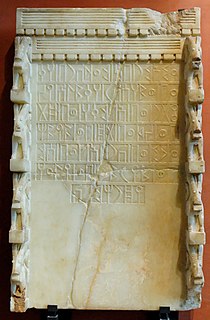Related Research Articles

The Arabs, also known as the Arab people, are an ethnic group mainly inhabiting the Arab world in Western Asia, North Africa, the Horn of Africa, and the western Indian Ocean islands. An Arab diaspora is also present around the world in significant numbers, most notably in the Americas, Western Europe, Turkey, Indonesia, and Iran.

The history of Saudi Arabia as a nation state began with the emergence of the Al Saud dynasty in central Arabia in 1744 and the subsequent establishment of the Emirate of Diriyah. Pre-Islamic Arabia, the territory that constitutes modern Saudi Arabia, was the site of several ancient cultures and civilizations; the prehistory of Saudi Arabia shows some of the earliest traces of human activity in the world.

The history of Yemen describes the cultures, events, and peoples of what is one of the oldest centers of civilization in the Near East. Its relatively fertile land and adequate rainfall in a moister climate helped sustain a stable population, a feature recognized by the ancient Greek geographer Ptolemy, who described Yemen as Eudaimon Arabia meaning "fortunate Arabia" or "Happy Arabia". Yemenis had developed the South Arabian alphabet by the 12th to 8th centuries BC, which explains why most historians date all of the ancient Yemeni kingdoms to that era.

The Arabian Peninsula, or Arabia, is a peninsula of Western Asia, situated northeast of Africa on the Arabian Plate. At 3,237,500 km2 (1,250,000 sq mi), the Arabian Peninsula is the largest peninsula in the world.

Yemen, officially the Republic of Yemen, is a country in Western Asia, on the southern end of the Arabian Peninsula. It borders Saudi Arabia to the north and Oman to the northeast and shares maritime borders with Eritrea, Djibouti, and Somalia. It is the second-largest Arab sovereign state in the peninsula, occupying 555,000 square kilometres. The coastline stretches for about 2,000 kilometres. Yemen's constitutionally stated capital, and largest city, is the city of Sanaa. As of 2021, the population of the country is estimated at 30,491,000.

Home to one of the Cradles of Civilization, the Middle East—interchangeable with the Near East—has seen many of the world's oldest cultures and civilizations. This history started from the earliest human settlements, continuing through several major pre- and post-Islamic Empires through to the nation-states of the Middle East today.

A Persianate society is a society that is based on or strongly influenced by the Persian language, culture, literature, art and/or identity.

The Pan-Arab colours are black, white, green, and red. Individually, each of the four Pan-Arab colours were intended to represent a certain aspect of the Arabs and their history. The black represents the Black Standard used by the Rashidun and Abbasid caliphates, white was the dynastic colour of the Umayyad and Fatimid caliphates, Green is a colour associated with the primary Arab religion of Islam – and therefore also a color representative of Rashidun Caliphates, and red was the Hashemite dynastic colour. The four colours also derived their potency from a verse by 14th century Iraqi poet Safi al-Din al-Hilli: "White are our acts, black our battles, green our fields, and red our swords".
Norman Itzkowitz was an American academic who was a professor of Near Eastern Studies at Princeton University. He was an Ottoman historian who brought perception of psychoanalysis into Near Eastern Studies.
John E. Woods is a Professor of Iranian and Central Asian History in the Departments of History and of Near Eastern Languages and Civilizations and the College at the University of Chicago.

The composite Turko-Persian, Turco-Persian or Turco-Iranian tradition was a distinctive culture that arose in the 9th and 10th centuries in Khorasan and Transoxiana. It was Persianate in that it was centered on a lettered tradition of Iranian origin, and it was Turkic insofar as it was founded by and for many generations patronized by rulers of Turkic heredity.

'Abd al-Rahman al-Kawakibi was a Syrian author and Pan-Arab solidarity supporter. He was one of the most prominent intellectuals of his time; however, his thoughts and writings continue to be relevant to the issues of Islamic identity and Pan-Arabism. His criticisms of the Ottoman Empire eventually led to Arabs calling for the sovereignty of the Arab Nations, setting the basis for Pan-Arab nationalism. Al-Kawakibi articulated his ideas in two influential books, Tabai al-Istibdad wa-Masari al-Isti’bad and Umm Al-Qura. He died in 1902 of “mysterious” causes. His family alleged that he was poisoned by Turkish agents.
Al-Mu'ayyad Abbas was an Imam of Yemen who ruled briefly in 1850. He belonged to the Qasimi family, descendants of the Islamic prophet Muhammad, who dominated the Zaidi imamate of Yemen between 1597 and 1962. Abbas bin Abd ar-Rahman was a scholar who descended from Imam al-Mutawakkil Isma'il in the sixth generation. He was a disciple of the renowned Yemeni scholar Muhammad ash-Shawkani. After the abortive Ottoman intervention in highland Yemen in 1849, the remains of the Zaidi state became the prey of political rivalries. The current imam al-Mansur Ali II was an alcoholic and commanded little respect; tribal groups rebelled, and the court in San'a was dominated by the oppressive minister al-Misri. Certain Sayyids and qadis in San'a defected to Sa'dah far to the north, where al-Mansur Ahmad bin Hashim posed as imam. Al-Mansur Ahmad besieged San'a in 1850. However, the elite of San'a chose Abbas as their imam, under the name al-Mu'ayyad Abbas. The new imam appointed Muhammad ash-Shawkani's son Ahmad as his qadi. His soldiers and emirs held out for a while against the attackers in the qasr (fortress) of the city. Finally he had to surrender to al-Mansur Ahmad and was imprisoned. The victor, however, could only maintain his position in San'a for three months before he was forced to flee to the Arhab tribe. In the following year 1851, the contenders for the Zaidi imamate agreed to appoint al-Hadi Ghalib. Al-Mu'ayyad Abbas withdrew to a life of scholarship and teaching until his demise in 1880.
Al-Hadi Sharaf ad-Din was a claimant for the Zaidi imamate of Yemen in the years 1878–1890, acting in opposition to the Ottoman occupiers of the country. His period saw a tribal embryo of a state taking form in the highlands of Yemen, which would be strengthened by his successors as imams, and eventually usher into the expulsion of the Ottoman Turks in the early 20th century.
Muhammad bin Yahya Hamid ad-Din was an Imam of Yemen who led the resistance against the Ottoman occupation in 1890–1904.

Christian influences in Islam can be traced back to Eastern Christianity, which surrounded the origins of Islam. Islam, emerging in the context of the Middle East that was largely Christian, was first seen as a Christological heresy known as the "heresy of the Ishmaelites", described as such in Concerning Heresy by Saint John of Damascus, a Syriac scholar.
Fawwaz Tuqan is a Jordanian-Palestinian poet, novelist and professor. He was born on 6 September 1940 to a notable Palestinian family in Jordan. His father is Ahmad Abdul Fattah Tuqan, a former Prime Minister of Jordan.

Yemen Vilayet was a first-level administrative division (vilayet) of the Ottoman Empire. At the beginning of the 20th century it reportedly had an area of 200,000 square kilometres (77,200 sq mi). The population for the vilayet is given by the 1885 Ottoman census as 2,500,000.
Middle Eastern Americans are Americans of Middle Eastern background. According to the United States Census Bureau, the term "Middle Eastern American" applies to anyone of West Asian or North African origin. This includes people whose background is from the various Middle Eastern and West Asian ethnic groups, such as the Kurds and Assyrians, as well as immigrants from modern-day countries of the Arab world, Iran, Israel, Turkey and sometimes Armenia.

The Yemeni–Ottoman conflicts were a series of conflicts between the Ottoman Empire and Zaidi tribes in Upper Yemen, which began in 1538 and ended with the signing of the Treaty of Daan on 9 October 1911.
References
- ↑ hist.umn.edu
- ↑ Search Results: University of Minnesota
- ↑ Directory of American Scholars, 6th ed. (Bowker, 1974), Vol. I, p. 187.
- ↑ Directory of American Scholars, 6th ed. (Bowker, 1974), Vol. I, p. 187; "Dr. Caesar Farah." StarTribune, December 1, 2009, accessed July 9, 2021.
- 1 2 3 4 5 6 7 8 9 Amazon.com: Subjects: Books: Nonfiction, Literature & Fiction, Professional & Technical, Science & More